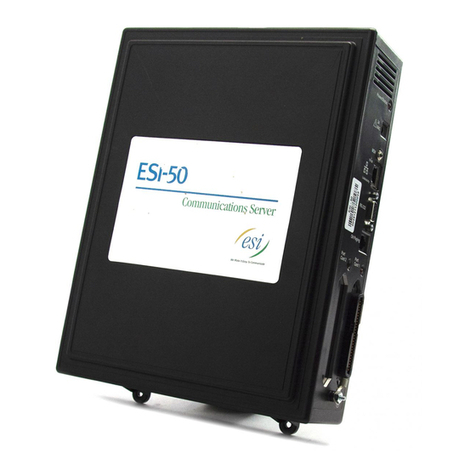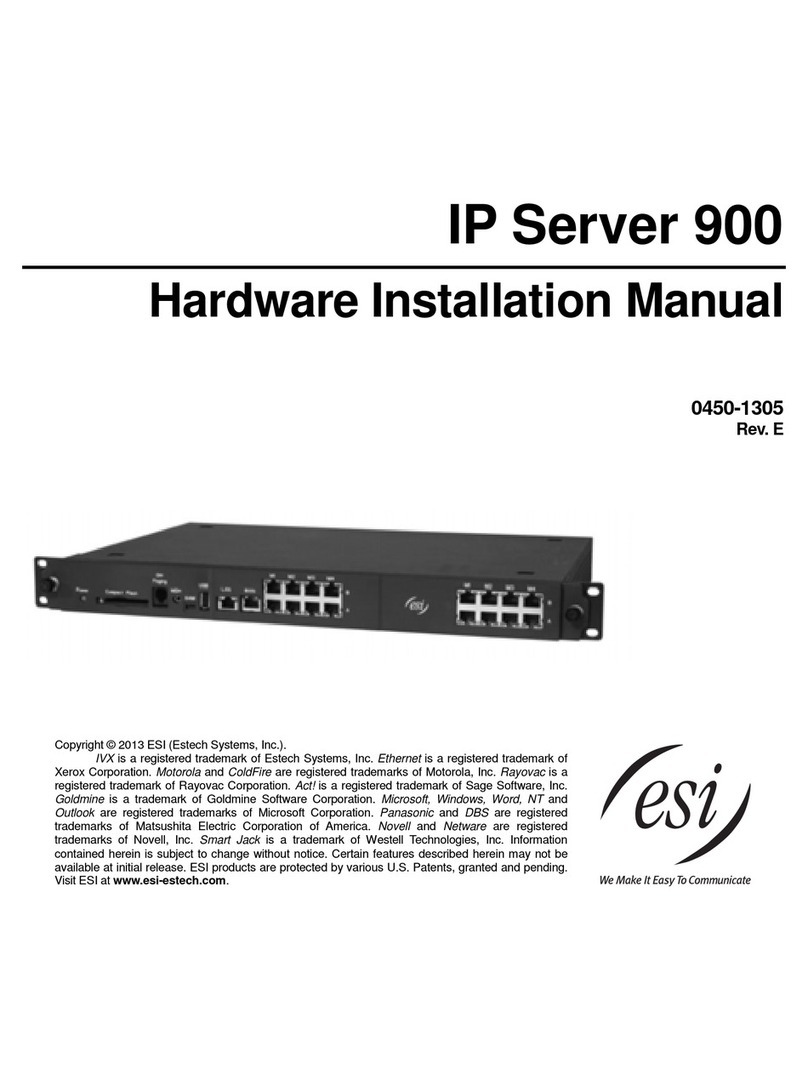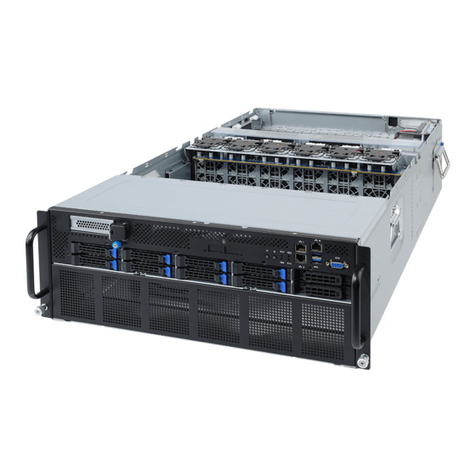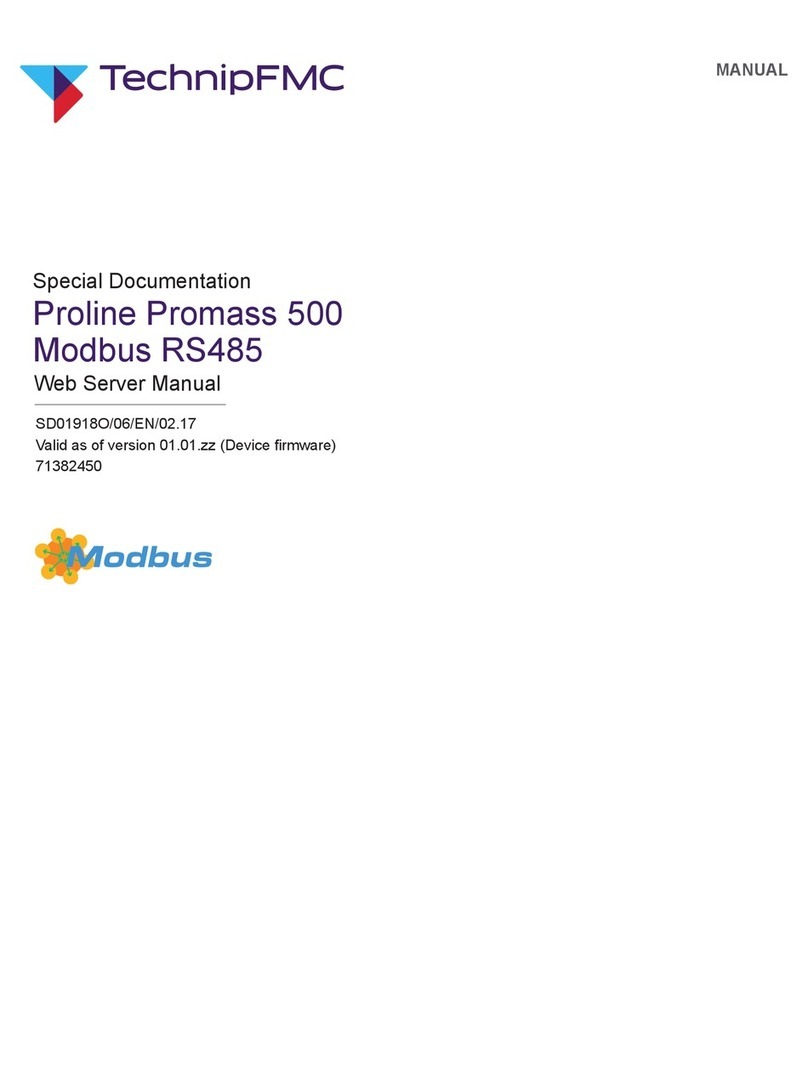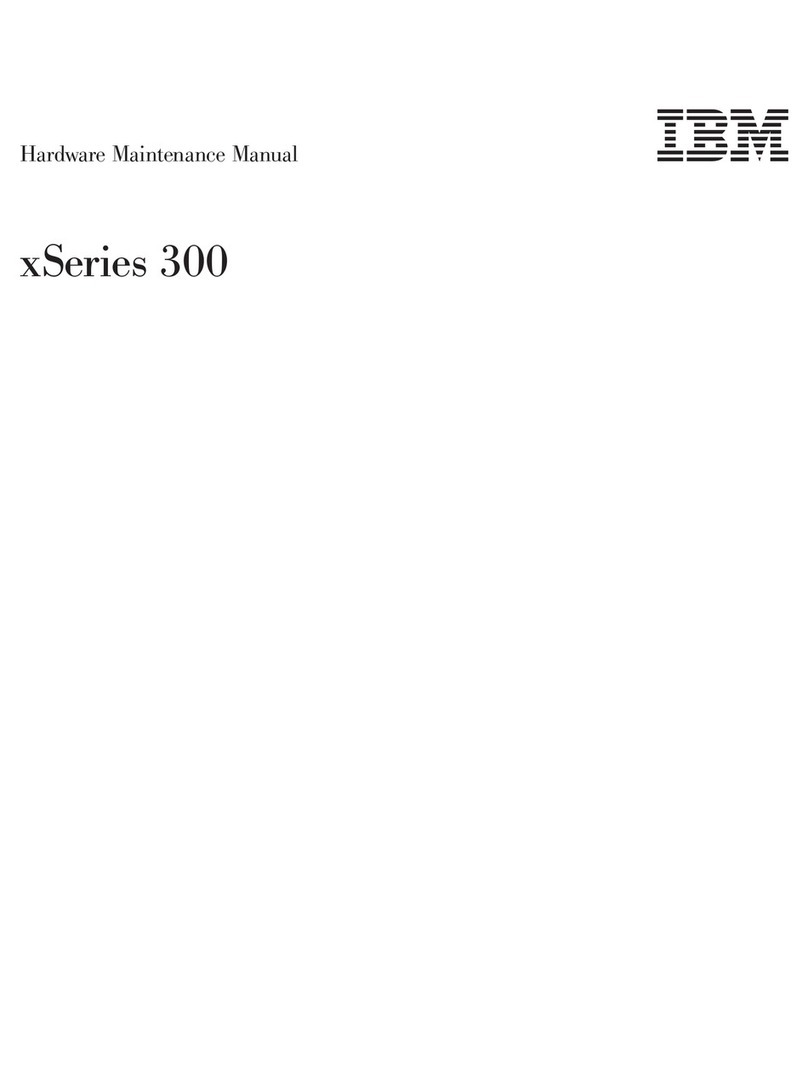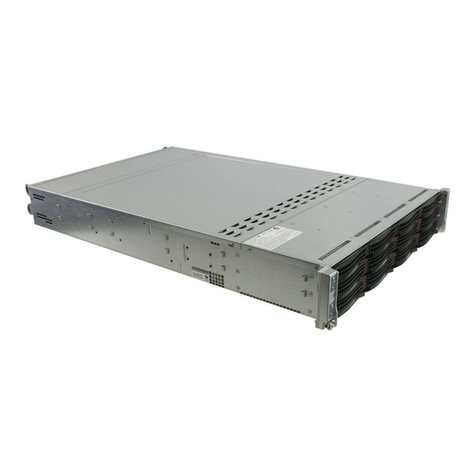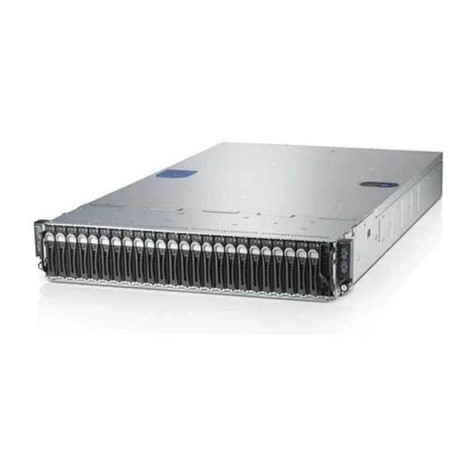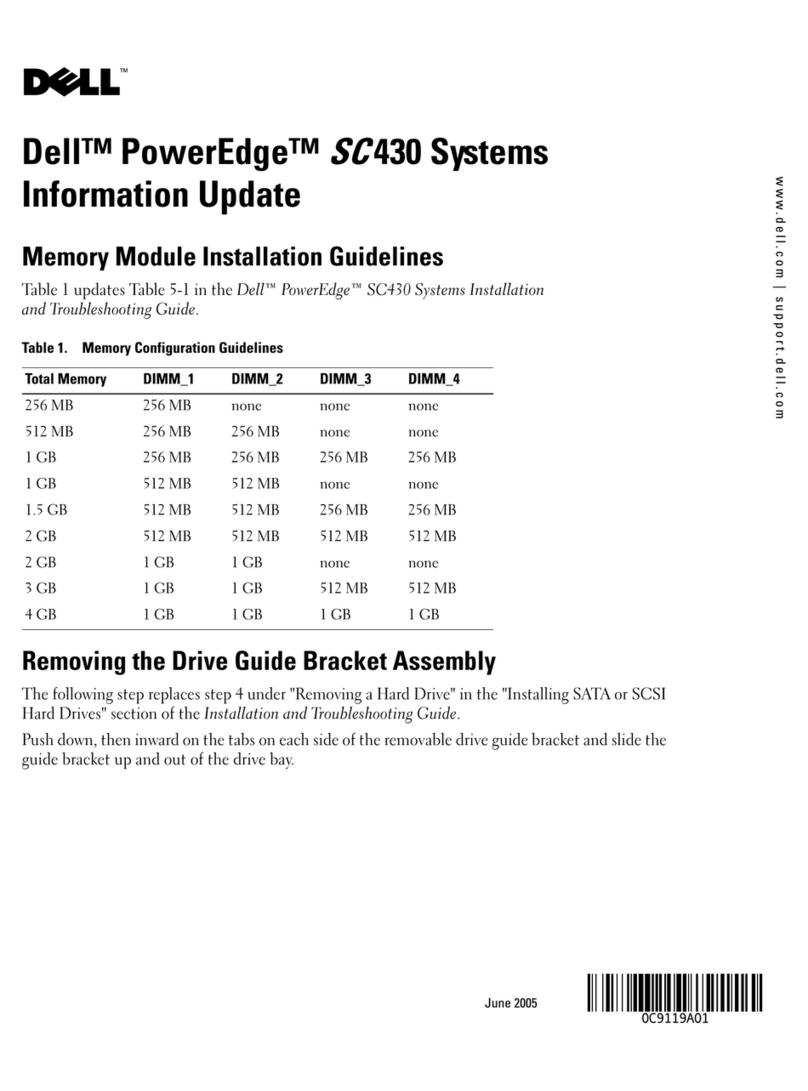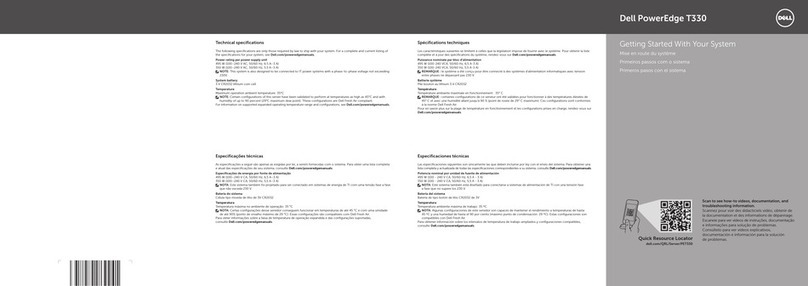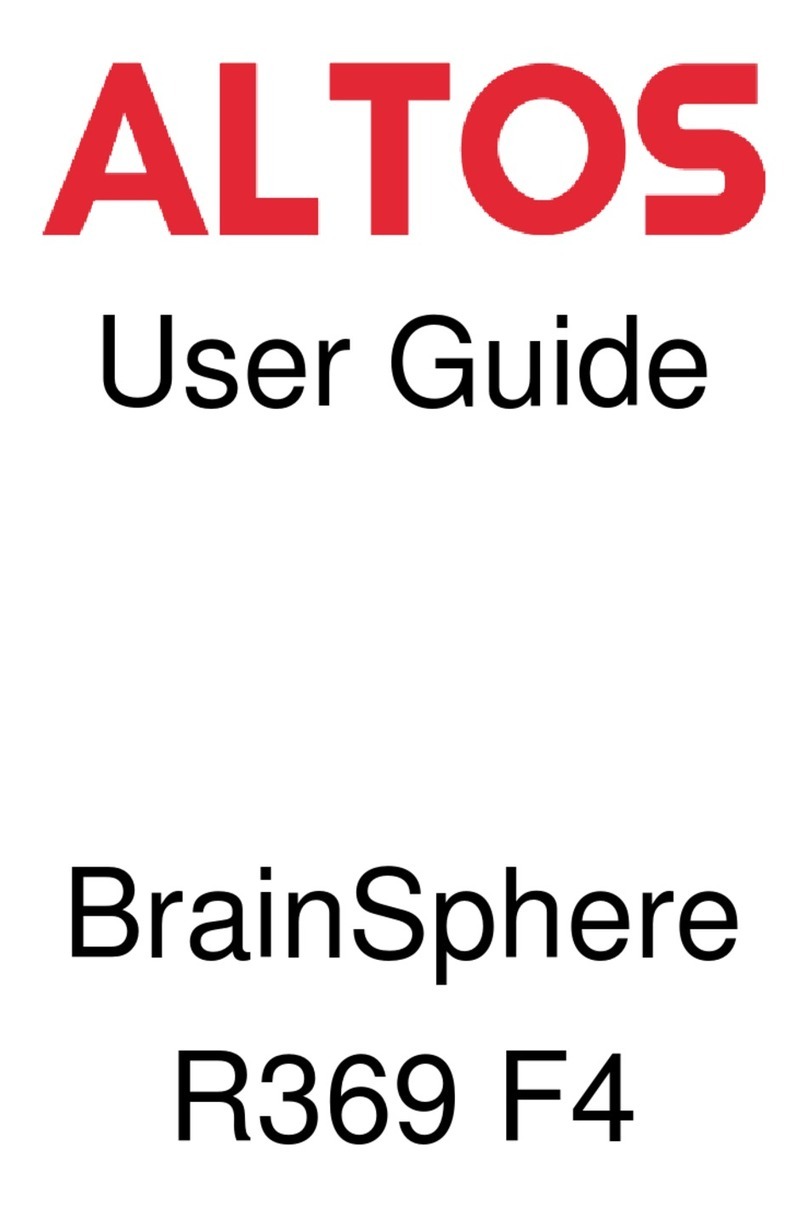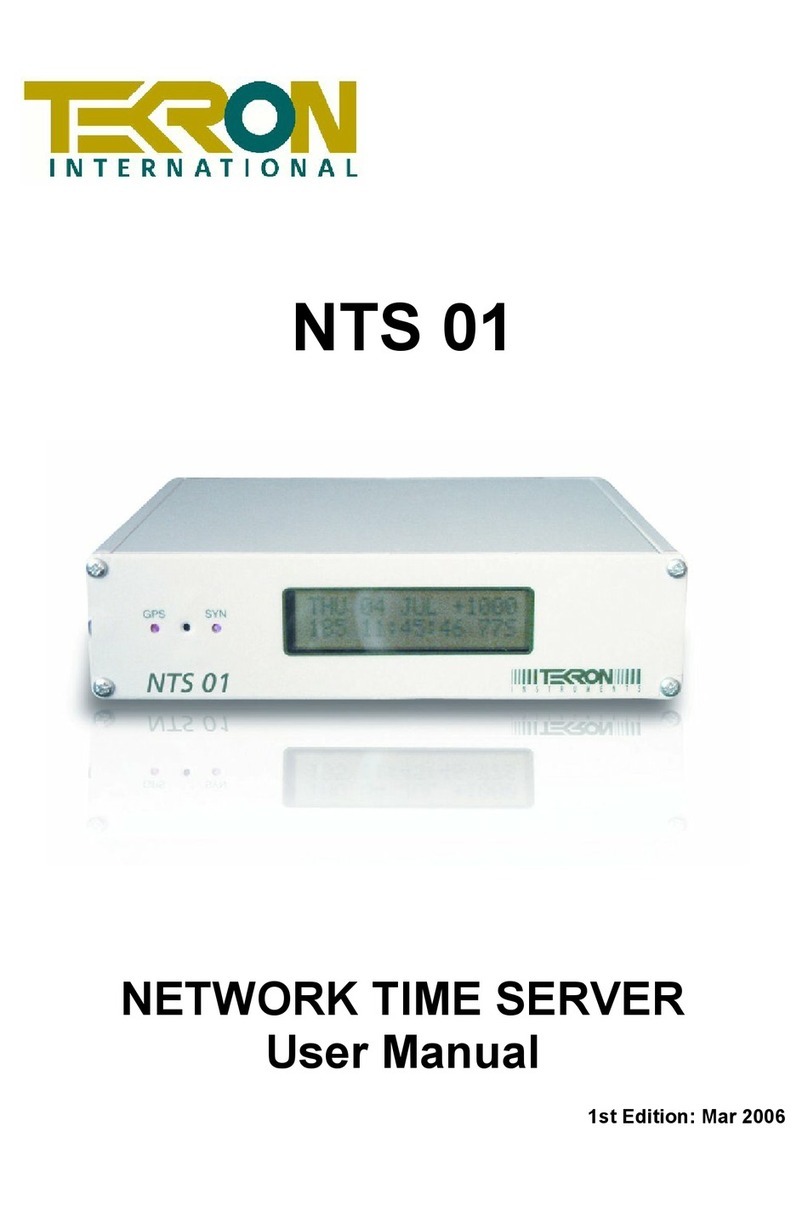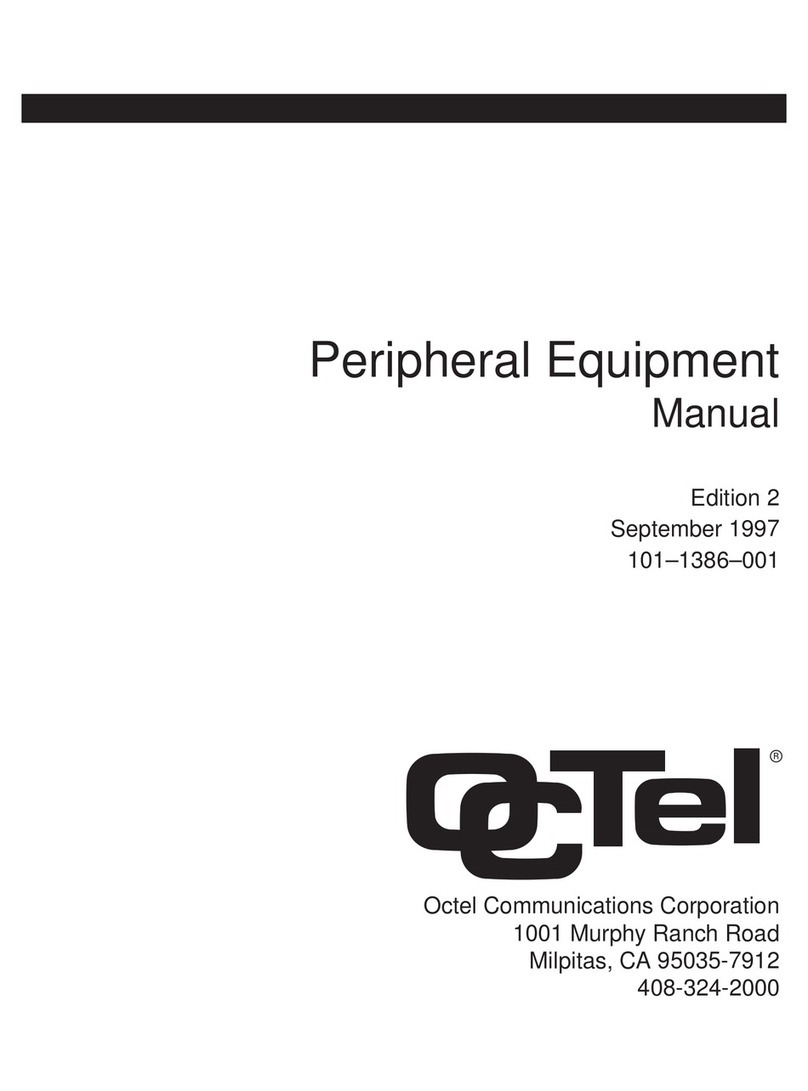ESI ESI-1000 User manual

ESI Communications Servers
ESI-1000 • ESI-600 • ESI-200 • ESI-100 • ESI-50
Hardware Installation Manual
0450-1049
Rev. J
Copyright © 2009 ESI (Estech Systems, Inc.).
IVX is a registered trademark of Estech Systems, Inc. Ethernet is a registered trademark of
Xerox Corporation. Motorola and ColdFire are registered trademarks of Motorola, Inc. Rayovac is a
registered trademark of Rayovac Corporation. Act! is a registered trademark of Symantec
Corporation. Goldmine is a trademark of Goldmine Software Corporation. Microsoft, Windows, NT
and Outlook are registered trademarks of Microsoft Corporation. Panasonic and DBS are registered
trademarks of Matsushita Electric Corporation of America. Novell and Netware are registered
trademarks of Novell, Inc. Smart Jack is a trademark of Westell Technologies, Inc. Information
contained herein is subject to change without notice. Certain features described herein may not be
available at initial release. ESI products are protected by various U.S. Patents, granted and pending.
Visit ESI on the Web at www.esi-estech.com.

Contents
Overview........................................................................A.1
Cabinetcomponents..............................................................A.1
Base Cabinet......................................................................... A.1
Expansion Cabinets...............................................................A.2
Main board.............................................................................A.2
Backplane..............................................................................A.2
Memory Module.....................................................................A.3
Power supply.........................................................................A.3
Port card options....................................................................A.4
NSP.......................................................................................A.7
Phones...........................................................................B.1
Digital phone models .............................................................B.1
IP Phone models...................................................................B.2
ESI Cordless Handsets..........................................................B.3
Expansion Consoles..............................................................B.3
Feature Phone overlays.........................................................B.4
VIP Softphone........................................................................B.4
Licensing.......................................................................C.1
System capacities.........................................................D.1
Cautions and regulatory information..........................E.1
Cautions ................................................................................E.1
Regulatory information...........................................................E.2
Hardware installation: ESI-1000, ESI-600, ESI-200.... F.1
Site location............................................................................F.1
Mounting thecabinet(s)...........................................................F.1
Expansion Cabinet installation................................................F.2
Port card installation................................................................F.2
About replacing port cards......................................................F.4
Memory Module installation or replacement............................F.5
Removing the Memory Module from the main board..............F.8
Mirrored Memory Module........................................................F.9
LED functions .......................................................................F.15
ESI Presence Management installation................................F.15
ESI Cellular Management installation....................................F.15
ESI Mobile Messaging installation.........................................F.15
ESI SIP trunking installation..................................................F.15
Hardware installation: ESI-100....................................G.1
Site location...........................................................................G.1
Opening the Base Cabinet.................................................... G.2
Mounting the Base Cabinet................................................... G.2
Expansion Cabinet installation............................................... G.3
Port card installation.............................................................. G.3
Memory Module installation or replacement.......................... G.5
LED functions........................................................................ G.6
ESI Presence Management installation................................. G.6
ESI Cellular Management installation.................................... G.6
ESI Mobile Messaging installation......................................... G.6
ESI SIP trunking installation.................................................. G.6
Hardware installation: ESI-50...................................... H.1
Site location............................................................................H.1
Opening the Base Cabinet.....................................................H.2
Mounting the Base Cabinet....................................................H.2
Expansion Cabinet installation................................................H.3
Port card installation...............................................................H.3
Memory Module installation or replacement...........................H.5
LED functions.........................................................................H.6
ESI Presence Management installation..................................H.6
ESI Cellular Management installation.....................................H.6
ESI Mobile Messaging installation..........................................H.6
ESI SIP trunking installation...................................................H.6
External connections.....................................................I.1
Grounding instructions............................................................I.1
Power......................................................................................I.1
MOH port................................................................................I.3
Maintenance/SMDR serial port................................................I.3
External paging device connection..........................................I.4
Amphenol cable connections................................................... I.4
CO line connection..................................................................I.5
Station connection...................................................................I.7
60-Key Expansion Console connection................................... I.8
60-Key Second Expansion Console connection......................I.9
Installing ESI’s Cordless Handsets........................................I.10
Port cardconnections............................................................I.13
Cabinet worksheets...............................................................I.23
Index
Important: For information concerning the programming of an ESI Communications Server (the ESI-1000,
ESI-600, ESI-200, ESI-100, or ESI-50), see the ESI Communications Servers Programming Manual
(ESI document # 0450-1050).
Statements in this document about ESI Communications Servers as a group do NOT pertain to the
ESI-50L, which must be upgraded to ESI-50 status to provide a number of usual ESI Communications
Server features (particularly those related to automatic call distribution, IP capabilities, and use of PRI).
For information concerning hardware installation of the the ESI-50L, please see the ESI-50L Hardware
Installation Manual (ESI document # 0450-1159).

ESI Communications Servers Hardware Installation Manual Overview
A.1
Overview
Cabinet components
ESI-1000, ESI-600, and ESI-200
Cabinet components1for the ESI-1000, ESI-600, and ESI-200 consist of:
• Base Cabinet
–Main board
–Backplane
–Memory Module
–Seven port card slots
–External wall-mounted power supply
• Expansion Cabinet (optional)
–Backplane
–Seven port card slots
–Expansion cable
–Expansion Card
–External wall-mounted power supply
ESI-100
The ESI-100’s cabinet components1consist of:
• Base Cabinet
–Main board
–Memory Module
–Two port card slots
–External wall-mounted power supply
• Expansion Cabinet (optional)
–Two port card slots
ESI-50
The ESI-50’s cabinet components1consist of:
• Base Cabinet
–Main board with built-in 482 and
SL-IVC 12 port cards
–Memory Module
–One port card slot
–External wall-mounted power supply
• Expansion Cabinet (optional)
–Two port card slots
Base Cabinet
The ESI Communications Server Base Cabinet is designed for easy installation and component access.
Regardless of model, each ESI Communications Server Base Cabinet houses the main board, Memory Module,
Network Services Processor (NSP), one multi-purpose serial port, and an MOH connector.
ESI-1000, ESI-600, and ESI-200
The Base Cabinet for the ESI-1000,ESI-600, and ESI-200, which measures 19″W 10.5″H 10.5″D, also
houses the Mirrored Memory Module (M3)2and seven port card slots (see “Port card options,” pageA.4).
ESI-100
The Base Cabinet for the ESI-100, which measures 8.5″W 11″H 3″D, also houses two port card slots
(see “Port card options,” page A.4).
ESI-50
The Base Cabinet for the ESI-50, which measures 8.5″W 11″H 3″D, has a main board with built-in 482
and IVC 12 port cards. italso houses an additionalport card slot (see “Port card options,” page A.4).
1Memory Modules and port cards are packaged separately and are mounted in each system’s cabinet during installation.
2The M3 interface is standard on the ESI-1000, optionalon the ESI-600 and hard drive-equipped ESI-200. Each requires an optionalsecond
Memory Module.

ESI Communications Servers Hardware Installation Manual Overview
A.2
Expansion Cabinets
Each ESI Communications Server can be expanded to increase the number ofport cards.The ESI-1000 and
ESI-600 each accept the same Expansion Cabinet, while the ESI-200, ESI-100, and ESI-50 have their own
unique Expansion Cabinets.
System Maximum
Expansion Cabinets Maximum port cards
per Expansion Cabinet Total system capacity
(port cards)
ESI-1000 5 7 42
ESI-600 3 7 28
ESI-200 1 7 14
ESI-100 1 2 4
ESI-50 1 2 3 (plus a built-in 482 and IVC 12)
Main board
The main board combines leading-edge hardware components — including a Motorola®ColdFire®processor
and DSPstructure — along with proprietary operating system software. The board provides: system control of
the Memory Module and port cards; a standard RS-232C DB9 serial port; a built-in modem for remote access;
an external paging-device interface; MOH interface; an NSP, which provides remote access via TCP/IP and
supports certain optional ESI PC software applications; and (except on the ESI-100 and ESI-50) a mount for the
Mirrored Memory Module.1
Backplane
On the ESI-1000, ESI-600, and ESI-200, each cabinet (Base or Expansion) is equipped with a backplane that
supports up to seven port cards.
1The M3 interface is standard on the ESI-1000, optionalon the ESI-600 and hard drive-equipped ESI-200. Each requires an optionalsecond
Memory Module.

ESI Communications Servers Hardware Installation Manual Overview
A.3
Memory Module
The Memory Module — a hard disk drive or CompactFlash®with proprietary formatting — contains all system
programming and configuration data, and pre-loaded voice prompts. The Memory Module provides voice
storage at64 kilobits per second — the industry's highest-quality sampling rate. Here are the capacities by
system model:
Memory Module type ESI-1000 ESI-600 ESI-200 ESI-100 ESI-50
CompactFlash n/a n/a 140-hr. 140-hr. 15-hr. and 60-hr.
Hard-disk drive 1,200-hr. 1,200-hr. 600-hr. n/a n/a
Optional Mirrored Memory Module (M3)
Note: Not available on the ESI-200 with CompactFlash, ESI-100, or ESI-50.
Using RAID-1 hard drive technology, the optional Mirrored Memory Module (M3) maintains system operation
on a separate disk drive in the event of a hard drive failure. M3 is required when redundancy ofsystem
programming, speed-dial entries, and voice mail messages and prompts is desired.
Note: M3 use on the ESI-200 requires that both Memory Modules be the 600-hour (hard-disk drive) model.
Power supply
All power supplies are included at purchase.
• ESI-1000, ESI-600, or ESI-200 — Uses a 7.5-amp, 24 VAC powersupply on the Base Cabinet and each
Expansion Cabinet.
• ESI-100 — Uses a 5-amp, 24 VAC power supply.
• ESI-50 — Uses a 3-amp, 24 VAC power supply.
Optional rack-mount Power Distribution Shelf
The optional Power Distribution Shelf can be mounted in a standard 19-inch rack. Each Power Distribution
Shelf, which can hold up to four power supplies, includes a six-outlet power strip with on/off switch and 15'
power cord.

ESI Communications Servers Hardware Installation Manual Overview
A.4
Port card options
ESI Communications Servers support a wide range of port cards. Any E2 port card can be used on any ESI
Communications Server with the use of an additional E2 Port Card “Hot Swap” Adapter (except on the ESI-100).1
The CS port cards (used with the ESI-1000, ESI-600, and ESI-200) are full-size cards with built-in “hot-swap”
capability, along with a special “ejector-handle” mechanism that makes them literally a snap to install or uninstall.
The following port cardsare supported:
Ports System maximums (port cards)
Port card COs Stations2Analog
stations Esi-Link
channels ESI-
1000 ESI-
600 ESI-
200 ESI-
100 ESI-
50
CS-684 6 8 digital 4 42 28 14
CS-612 6 12 digital 42 28 14
CS-6ALC 6 42 28 14
CS-A12 12 32 15 4
CS-D12 12 digital 42 28 14
CS-DLC12 24 (T1)
or 23B +1D (PRI) 12 digital 10 6 3
CS-DLC 24 (T1)
or 23B +1D (PRI) 10 6 3
CS-IVC 24R 24 IP 34 17 8
CS-IVC 24EL 24 4 2 1
CS-IVC 12R12EL 12 IP 12 4 2 1
E2-684 6 8 digital 4 42 28 14 4
E2-612 6 12 digital 42 28 14 4
ESI-6ALC 6 42 28 14 4
E2-A434 32 15 4 2
E2-A12 12 32 15 4 2
E2-D12 12 digital 42 28 14 4
E2-DLC12 24 (T1)
or 23B +1D (PRI) 12 digital 10 6 3 1
ESI-DLC 24 (T1)
or 23B +1D (PRI) 10 6 3 1
IVC 24R424 IP 34 17 8 3
IVC 24EL 24 4 2 1 1
IVC 12R12EL 12 IP 12 4 2 1 1
SL-DLC82 23B +1D (PRI) 8 digital 2 1
482 4 8 digital 2 4
5
SL-IVC 12 12 local IP or
8 remote IP 8 16
CS-SIP24 24 10 6 3 1 1
CS-SIP8 8 10 6 3 1 1
CS-ASC 10 6 3 1 1
The cards are described beginning on the next page.
Warning: Any port card shipped prior to March 16, 2007, will NOT boot on the second cabinet of an ESI-200.
However, these cards can be updated. For details and the update procedure, see Technical Update 264,
available from www.esiresellers.com/tech.
1See “Hot-swap operations,” page A.7.
2For each IVC, the quantity of IP stations is a combination of locally and remotely installed IP phones.
3Not supported on the ESI-50 (or ESI-50L).
4Previously called IVCR24.
5One of the four 482 cards is built-in (ESI-50 only).
6Built into the main board (ESI-50 only); see also “Port card descriptions,” page A.5.

ESI Communications Servers Hardware Installation Manual Overview
A.5
Port card descriptions
• CS-684, E2-684 — Connects up to six analog loop-start CO lines, eight Digital Feature Phones and four
analog station ports. The CO line ports supportstandard CO and Centrex loop-start lines (but not ground-
start CO lines).The analog ports provide a standard 24-volt, two-wire connection to fax machines,
courtesy phones, modems, etc. Only one device can be connected to each analog station port. This card
uses 12 station ports and six CO ports.
• CS-612, E2-612 — Provides circuits to connect up to six analog loop-start CO lines and 12 Digital Feature
Phones. Ground-start CO lines are not supported. This card uses 12 station ports and six CO ports.
• CS-6ALC, ESI-6ALC — Similar to the CS-612 and E2-612, but connects only up to six analog loop-start
CO lines (and no stations).
• E2-A41— Connects up to four analog devices (only), such as fax machines and cordless phones. This card
uses four station ports and no CO ports. Each port provides a standard 24-volt, two-wire phone
connection. Only one analog device can be connected to each port.
• CS-A12, E2-A12 — Connects up to 12 analog devices (only), such as fax machines and cordless phones.
Thiscard uses 12 station ports and no CO ports. Each port provides a standard 24-volt, two-wire phone
connection. Only one analog device can be connected to each port.
• CS-D12, E2-D12 — Connects up to 12 Digital Feature Phones (only). This card uses 12 station ports and
no CO ports.
• CS-DLC12, E2-DLC12 (Digital Line Card) — Provides either a T1 interface supporting 24 DS0 channels
and 12 digital stations or an ISDN PRI interface supporting 23 B (bearer) channels, one D (datalink)
channel, and 12 digital stations.
A jumperon this card must be plugged onto pins 7 and 8 of J3 to enable ISDN PRI functions.Any
(or all)of the available channels of the T1/PRI span (24 on T1,23 on PRI)can be assigned, and the card
supports loop-start, ground-start, E&M and DNIS/DID trunk types with immediate, wink-start or dial-tone-
start signaling. This card is equipped with a built-in CSU that can be connected directly to a network
interface unit, SmartJack, or ISDN PRI. Up to 12 Digital Feature Phones can be connected to the card.
All 24 CO ports are allocated (regardless of whether they are assigned or used).
• CS-DLC, ESI-DLC — Similar to the CS-DLC12 and E2-DLC12, but supports only a T1 or PRI circuit (and
no phones).
• CS-IVC, IVC (Intelligent VoIP Card) — Supports standards-compliant IP telephony service and features,
including VoIP to the desktop and Esi-Link. It features highly configurable DSP technology that manages
the flow of traffic among the port cards and converts IP packets into PCM (pulse-code modulation) traffic
for transmission over the PSTN.The physical connection is a 10/100Base-T, RJ-45 Ethernet®interface
thatallows the system to connect to an IP-based localarea network (LAN).
The IVC is offered in three versions:
• IVC 24R — Provides 24 IP stations (local or remote).2
• IVC 24EL — Provides 24 channels for Esi-Link.
• IVC 12R12EL — Provides 12 IP stations (local or remote) and 12 Esi-Link channels; does not
support SIP phones.
Each ESI Communications Server model has a specific maximum of each type of IVC (see the table
on page A.4).The system automatically designates the first IVC station card (lowest-numbered slot)as
the primary IVC — which acts as the “master” that, when an IP Phone first comes on line, identifies the
IVC station card to which the IPPhone connects (IVC Esi-Link cards are excluded from this operation).
Licensing is required to support each IP Feature Phone or SIP phone. The following table shows the
maximum number of IP Phones and Esi-Link channels for each system.
Maximums ESI-1000 ESI-600 ESI-200 ESI-100
IP stations 816 408 192 72
Esi-Link channels 96 48 24 243
(Continued)
1Not supported on the ESI-50 (or ESI-50L).
2SIP phones are supported on only the IVC 24R.
3With (E2) IVC 24EL.

ESI Communications Servers Hardware Installation Manual Overview
A.6
• SL-DLC82 — (ESI-50 only.) Provides an ISDN PRI interface supporting 23 B (bearer) channels, one D
(datalink) channel, eight digital stations, and two analog devices.
A jumperon this card must be plugged onto pins 7 and 8 of J3 to enable ISDN PRI functions.
Any (or all) of the 23 available channels of the PRI span can be assigned, and the card supports loop-start,
ground-start, E&M and DNIS/DID trunk types with immediate, wink-start or dial-tone-start signaling.
This card is equipped with a built-in CSU that can be connected directly to a network interface unit,
SmartJack, or ISDN PRI. Up to eightDigital Feature Phones and up to two analog phones can be
connected to the card.All 24 CO ports are allocated (regardless of whether they are assigned or used).
• 482 — (ESI-50 [and ESI-50L] only.1) Provides circuits to connect up to four loop-start CO lines, eight
Digital Feature Phones, and two analog station ports. The CO line ports support standard CO and Centrex
loop-start lines; ground-start CO lines are not supported. Only one analog device can be connected to
each analog station port. This card uses 10 station ports and four CO ports when installed.
Notes: The main board comes in a four-line, eight-digital station, two-analog port configuration. You can add
three 482 port cards on an ESI-50. Therefore, the system can have the following configurations.
— 4 8 2: Base Cabinet (main board only)
— 8 16 4: Base Cabinet with one additional 482 port card.
— 12 24 6: Base Cabinet with one additional 482 port card and an Expansion Cabinet
with one 482 port card.
— 16 32 8: Base Cabinet with one additional 482 port card and an Expansion Cabinet with
two 482 port cards.
The maximum ESI-50 configuration — if an SL-DLC82 is used in slot 2 and the built-in IVC (see next
item) uses all 12 local IP channels — is 35 x 44 x 8.
• SL-IVC 12 — (ESI-50 only.) The ESI-50’s built-in SL-IVC 12 can supportup to 12 IP channels, which support
up to 12 local IP stations, or up to eight remote IP channels. Local IP, remote IP, and Esi-Link channels
can be used in various combinations, which are activated in blocks of four for local IP, singles for remote IP,
and blocks of four for Esi-Link. Here is an example of some possible IVC 12 channel combinations:
–Eight all Esi-Link.
–12 all local IP.
–Eight Esi-Link, four local IP.
–Four Esi-Link, four local IP, four remote IP.
Important: The SL-IVC 12 is part of the ESI-50 main board; it is not available as an add-on port card.
• CS-SIP24 — Provides 24 SIP trunk ports and supports ESI Mobile Messaging delivery of .WAV files to
e-mail addresses.
• CS-SIP8 — Provides eight SIP trunk ports and supports ESI Mobile Messaging delivery of .WAV files to
e-mail addresses.
• CS-ASC (Application Services Card) — Supports ESI Mobile Messaging delivery of .WAV files to
e-mail addresses.
1The 482 card also is used by ESI’s C-Plus and IVX S-Class (Generations I–II) systems.

ESI Communications Servers Hardware Installation Manual Overview
A.7
Hot-swap operations
“CS” port cards — full-sized cards for use on only the ESI-1000, ESI-600,and ESI-200 — have built-in
hot-swap capability, allowing you to replace them while the system is powered-up.
For hot-swap capability, an “E2” port card must be mounted onto a “Hot Swap” Port Card Adapter (ESI part
#5000-0462) prior to being installed on the ESI-1000, ESI-600, or ESI-200. However, installing a new port
card requires power-cycling the system to allow it to recognize the new card.
The following rules apply to hot-swap operations on ESI Communications Servers:
• The ESI-100 and ESI-50 do not support hot-swapping; this capability is available on only the ESI-1000,
ESI-600, and ESI-200.
• When you replace a port card with a new one, the system will detect the port card type.
• If the new port card’s type is different than that of the original port card, the newly installed port card
won’t come on-line.
• If the new port card’s type is the same as that of the original port card, the system will automatically
upload software to the new port card. This upload process can take from four minutes to one hour,
depending on the type ofport card and how busy the system is at the time.
For details, refer to the procedure in “About replacing port cards,” page F.4.
NSP
Built into the main board, the NSP (Network Services Processor) serves as a bridge between an Ethernet-
based network and the ESI Communications Server. Using TCP/IP, the NSP communicates directly with specific
PC applications for maintenance of, and integration with, the ESI phone system. The NSP manages optional
features such as VIP and phone controlvia TAPI PC applications; it also provides access to not only
maintenance and administration (through use of ESI System Programmer software) but also an Installer-
selectable SMDR interface.
The NSP hardware interface consists ofa dedicated Ethernet port. Its external RJ-45 jack provides a
10/100Base-T connection to the LAN. The NSP consumes no call-processing ports.
Note: The ESI-50 provides one Ethernet port for access to the NSP and built-in IVC12.

ESI Communications Servers Hardware Installation Manual Phones
B.1
Phones
Digital phone models
An ESI Communications Server supports several different models ofESI digital phones, each of which
connects to the cabinet via standard two-wire twisted pair:
• 48-Key Digital Feature Phone — Three-line, 56-character1display (backlit display available);
speakerphone; headset jack2; 30 programmable feature keys; the only one of the three Digital Feature
Phones that supports VIP or the 60-Key Expansion Consoles.
Note: Not all modular headsets will work on the 48-Key Feature Phone’s headset jack. ESI has tested and can
recommend the following headset models:
Manufacturer: Plantronics
— P51-U10P sound tube microphone
— P51N-U10P noise-cancelling microphone
— P251-U10P sound tube microphone
— P251N-U10P noise-cancelling microphone
Manufacturer: GN Netcom
— GN2120 NCD 01 “over-the-head”
— GN2127 NCD 01 “on-the-ear”
Note that GN Netcom models also are available in a “-02” configuration, which wires differently and
won’t work with ESI phones. Therefore, when ordering GN Netcom headsets for use with ESI phones,
be sure to specify the “-01” configuration.
• 24-Key Digital Feature Phone — Two-line, 32-character display (backlit display available); speakerphone; 12
programmable feature keys.
• 12-Key Digital Feature Phone — One-line, 16-character display; nine programmable feature keys.
• Cordless Handset II — DECT 6.0 technology (including use of optional Repeater to extend range); two-line,
32-character display; speakerphone;eight programmable feature keys.
• [Original] Cordless Handset — Two sizes; two-line, 32-character display; four programmable feature keys.
Note: When a desktop phone is in the highest upright position, use the wall-mount hook located under the
handset to secure the handset when you’re not using the phone.
1The top two lines each have 16 characters, as on the 24-Key Digital Feature Phone; the bottom line has 24 characters.
2Headset jack only on 48-Key Feature Phones (Digital, Digital TAPI, [local] IP, or Remote IP) manufactured after March, 2004.

ESI Communications Servers Hardware Installation Manual Phones
B.2
IP Phone models
ESI Communications Servers support the IP Feature Phone II, Local IP Cordless Handset II, Local IP
[original] Cordless Handset, Remote IP Cordless Handset II, and Remote IP [original] Cordless Handset.
(See “ESI Cordless Handsets,” below.)
The desktop IP Feature Phone II1looks and works like a 48-Key Digital Feature Phone as described on pageB.1,
but connects from within the local premises via an IP local area network (LAN) rather than twisted-pair cabling.
If used on-premises, the IP Feature Phone II derives its operating power directly over the LAN from Powerover
Ethernet (PoE). If used remotely, the IP Feature Phone II connects to the cabinet from a remote location via an
IP network (either a WAN or the public Internet).Each IP Feature Phone II derives its power from an individual
Power over Ethernet (PoE) adapter. (As with the 48-Key DIgital Feature Phone, a backlit display is available.)
The IP Feature Phone II supports the following features and standards:
• IEEE 802.3af Power over Ethernet (PoE).
• Power via PoE.
• Can be configured foreither local or remote (off-site) operation.
• Uses a G.711 codec in its “local” mode of operation and a G.726 codec in its “remote” mode. In G.711 mode,
the transfer rate is 206 Kbps; in G.726 mode, the transfer rate is 90 Kbps.
• Can use DHCP2to obtain an IP address:
–In “local” operation, DHCP can be enabled or disabled3for the IP Phones on each IVC. Alternatively, a
“static” IP address may be assigned by the Installer (in Function 31; see the ESI Communications
Servers Programming Manual, ESI document #0450-1050).
–In “remote”operation, the IP Feature Phone II automatically uses DHCP to obtain an IP address and
default gateway.
• Complies with IEEE 802.1q and 802.1p (VLAN) Layer 2 switching and prioritization.
• Complies with differentiated services (DiffServ; RFC 2475) Layer 3 Quality of Service (QoS) implementations.
Notes: If connecting the IP Feature Phone II to a Power over Ethernet source, the PoE cable must be connected to
the jack labeled NETWORK on the base of the phone. The jack labeled PC does NOT support or provide
Power over Ethernet.
ESI has tested the IP Feature Phone II with several Power over Ethernet sources. For a current list of tested
devices, see www.esiresellers.com/PoE.
Important: The ESI IP Feature Phone II doesn’t work withESI’s IP E-Class or IVX®systems; it is for use with only ESI
Communications Servers (except the ESI-50L, which doesn’t support IP devices). Similarly, previous
IP Feature Phone models (including the Remote IP Feature Phone) don’t work with ESI Communications
Servers. Instead, they are intended for use with only IP E-Class and appropriate, IP-enabled IVX systems.
1ESI’s desktop IP Feature Phone comes only in a 48-key model.
2Dynamic Host Configuration Protocol, an IP standard described in RFC 2131 (http://www.ietf.org/rfc/rfc2131.txt).
3Default setting for DHCP is disabled.

ESI Communications Servers Hardware Installation Manual Phones
B.3
ESI Cordless Handsets
ESI Communications Servers also support ESI’s digital, Local IP, and Remote IPCordless Handsets — both
the Cordless Handset II and the original ESI Cordless Handset models.
Cordless Handset II
The ESI Cordless Handset II includes seven familiar fixed feature keys, eight programmable feature keys, a
speakerphone,and a headset jack.The Base Station for the ESI Digital Cordless Handset II uses a standard
line cord and is line-powered; and the Base Station for each ESI IP Cordless Handset II (Local IP or Remote
IP) uses Ethernet cabling, and receives (and requires) Power over Ethernet (PoE).The ESI Remote IP
Cordless Handset II base station also includes a jack into which the usercan plug an analog CO line. This
gives the home-based teleworker the convenience of using both home and business lines with the ESI
Remote IP Cordless Handset II. Each ESI Cordless Handset II model employs advanced DECT 6.0
technology which, as compared to the original ESI Cordless Handsets, allows more secure communications
and — through the use of one or more optionalESI Cordless Handset II Repeaters — greater range.
Original Cordless Handsets
The original ESI Cordless Handsets come in two sizes — small and large — and each includes four familiar
fixed featurekeys,four programmable feature keys,and a headset jack. The Base Station for each ESIdigital
Cordless Handset uses a standard line cord and is line-powered; and the Base Station foreach ESI IP
Cordless Handset uses Ethernet cabling and receives (and requires) Power over Ethernet (PoE).The ESI
Remote IP Cordless Handsetbase station also includes a jack intowhich the usercan plug an analog CO
line. This gives the home-based teleworker the convenience of using both home and business lines with the
ESI Remote IP Cordless Handset.
Important: The 48-Key IP Feature Phone II, Local IP Cordless Handset, and Remote IP Cordless Handset each draw up
to 7.25 watts1at 48 volts DC; therefore, they advertise themselves to a Power over Ethernet switch as Class 3
devices per the 802.3af standard. Most PoE switches adhering to this standard will provide up to 12.5 wattsfor
each Class 3 device.
Expansion Consoles
The 60-Key Expansion Console gives a designated user 60 additionalprogrammable feature keys. The
Expansion Console is connected to its host 48-Key Feature Phone via a special cable (provided) anddoesn’t
require a separate station port of its own.Additionally, it may be connected to a60-Key Second Expansion
Console via a special cable (provided with the 60-Key Second Expansion Console) so that one 48-Key Feature
Phone can have a total of150 programmable feature keys.
Each ESI Communications Server has a maximum number ofstations that can have one or two Expansion
Consoles (60-Key and 60-Key Second) installed in a fully configured system:
Maximum Expansion Consoles
ESI-1000 ESI-600 ESI-200 ESI-100 ESI-50
128 80 32 8 8
Note: Regardless of ESI Communications Server model, a Base Cabinet can support a maximum of eight
Expansion Consoles, and each Expansion Cabinet can support a maximum of 24 Expansion Consoles.
1The 48-Key IP Feature Phone II’s powerconsumption takes into account an optional 60-Key Expansion Console.

ESI Communications Servers Hardware Installation Manual Phones
B.4
Feature Phone overlays
Each Feature Phone comes with one overlay for the programmable feature keys. To order additional overlays,
visit the DESI™Web site, www.desi.com. While there,you may also want to download the free Windows-based
software, DESI Lite, which allows you to print on the overlays. For assistance with DESIproducts, contact DESI
(the DESI Web site contains contact information).
Tip: Remember that ESI System Programmer software, available from www.esiresellers.com, also lets you
print on the overlays as well as perform many other programming tasks.
VIP Softphone
VIP Softphone integrates the features of VIP Professional and an IP Feature Phone II into a PC-based, full-
audio phone. With the appropriate license, VIP Softphone can be configured for use locally or remotely. This
product requires a third-party USB headset.
Note: For details, see the VIP Product Overview (ESI document #0450-0608) and the VIP Setup and User’s Guide
(ESI document # 0450-0513).

ESI Communications Servers Hardware Installation Manual Licensing
C.1
Licensing
There are various types of licenses needed to activate certain features and functionality. The followingESI
Communications Server-supported features, products, and capabilities require license activation:
• IP Feature Phones (including Cordless Handsets) — Two license types:
–Local (LAN) operation.
–Remote (off-site) operation.1
• VIP.
• VIP Professional.
• VIP PC Attendant Console.
• VIP ACD Supervisor.
• VIP ACD Agent.
• VIP Softphone (also requires purchase of local or remote IP station license).
• SIP.
License activation
To have licenses activated by ESI TechnicalSupport:
1. Licenses must already have been ordered from ESI.
2. The ESI Communications Server must have either:
• A CO line connected to it (analog, PRI, or T1);
or
• The NSP, which is connected to a LAN with a public IP address, “port-forwarded”2to it.
3. You’ll need the following to provide to the ESI representative:
• The ESI sales order number.
• The customer (site) name.
• The phone number of the CO line or the public IP address of the NSP.
• The quantity of VIP Professional and VIP ACD Agent licenses.3
IP Phone licenses
Before an IVC will connect to an IP Phone4, the phone will require an available IVC port and the activation within
the system of a local or remote license. When an IP Phone is programmed in the system (Function 31), this
consumes a license.
A new compatible ESI IP Phone, when connected to a LAN with an ESI Communications Server connected to it,
can be configured in setup mode. However, if a new extension number is assigned to the phone and there are
no local IP Phone licenses available, the phone will display LICENSE EXCEEDED (but play no prompt).
Important: The ESI-50 also requires purchase of IP/Esi-Link feature activation. For more information about this fee,
contact your ESI sales representative at 800 374-0422.
1IP Feature Phones II programmed for remote operation can still operate as local stations on the LAN.
2For more information about the NSP, refer to NSP Installation Made Simple (ESI #0450-0669).
3VIPACD Agent uses the same license part numbers as VIP Professional, allowing mixing and matching as the customer mayrequire; e.g., 100 such
licenses could be used for 60 VIP Professional installations and 40 VIP ACD Agent installations. For licensing information for VIP PC Attendant Console
and VIP ACD Supervisor, refer to their respective Product Overviews (ESI document #0450-0914 for VIP PC Attendant Console and #0450-0988 for
VIP ACD). VIP Softphone is sold as a single license (part #5000-0434), which provides one user with VIP Professional features and Softphone-
specific capabilities. The VIP Softphone license is selected at the time of purchase for local or remote operation.
4An IP Feature Phone II, IP Cordless Handset (Local or Remote), VIP Softphone, or SIP phone.

ESI Communications Servers Hardware Installation Manual System capacities
D.1
System capacities
Important: Each ESI Presence Management RFID Reader uses one digital station. The same is true for each ESI
Cellular Management Access Device.
Stations and trunks
The specifications shown below reflect maximum capacities and configurations.Not all of the station and trunk
maximums can be reached simultaneously.
Example: The ESI-100 can’t achieve 72 IP stations and 48 digital stations and 28 analog stations and 42 trunks
and 24 Esi-Link stations at the same time, because the system’s four-port-card limit makes such a
configuration impossible. The maximum configuration for this system is 108 ports, which could be achieved
by one DLC12 card (24 T1 trunks, 12 digital stations), two IVC 24Rs (48 IP stations), andone IVC EL24
(24 Esi-Link channels).
ESI-1000 ESI-600 ESI-200 ESI-100 ESI-50
Dialing plans (-digits)
Four Three Four Three Four Three Four Three Four Three
Max. port cards 42 14 28 14 14 14 4 4 414
1
Max. port configuration21,128 276 624 276 300 276 108 108 87 87
– Max. stations 816 168 408 168 192 168 84 84 52 52
– Max. IP stations 816 168 408 168 192 168 72 72 12 12
– Max. digital stations 504 168 336 168 168 168 48 48 32 32
– Max. analog stations 384 56 188 56 56 56 28 28 8 8
Max. CO lines 240 84 168 84 84 84 42 42 35 35
Max. DLCs (T1/PRI) 10 3 6 3 3 3 1 1 131
3
Max. IVCs 34 7 17 7 8 7 3 3 141
4
Max. Esi-Link port cards (up to 24
Esi-Link channels5per card) 4 4 2 2 1 1 1 1 1 1
Max. SIP trunk cards 10 3 6 3 3 3 1 1 1 1
Dedicated ports
ESI-1000 ESI-600 ESI-200 ESI-100 ESI-50
Dialing plans (-digits)
Four Three Four Three Four Three Four Three Four Three
Voice mail/auto attendant ports6128 128 32 32 16 or 24
16 or 24
8 8 8 8
Conference ports (max. of 16
members per conference) 64 64 64 64 24 24 16 16 16 16
NSP71 1 1 1 1 1 1 1 1 1
Overhead paging ports81 1 1 1 1 1 1 1 1 1
Serial/SMDR ports 1 1 1 1 1 1 1 1 1 1
Voice mail capacities
ESI-1000 ESI-600 ESI-200 ESI-100 ESI-50
Dialing plans (-digits)
Four Three Four Three Four Three Four Three Four Three
Voice mail storage (hours) 1,200 1,200 1,200 1,200 140 or
600 140 or
600 140 140 15 or 60
15 or 60
Broadcast mailbox (one to
all extensions) Yes Yes Yes Yes Yes Yes Yes Yes Yes Yes
Cascade notification mailboxes 40 10 20 10 10 10 10 10 10 10
Group mailboxes/max. members 64/200 32/200 32/64 32/64 16/64 16/64 16/32 16/32 16/32 16/32
Guest/info mailboxes 1,000 190 1,000 190 1,000 190 1,000 190 190 190
Maximum station mailboxes 816 168 408 168 192 168 84 84 52 52
Q & Amailboxes 20 10 20 10 10 10 10 10 10 10
1Includes built-in 482 port card.
2Includes Esi-Link channels.
3ESI-50 supports only PRI.
4IVC 12 is built intoESI-50 main board;supports upto 12 local IP or up to eight remote IPchannels.
5Esi-Link channels are allocated to “reserved” ports; i.e. Esi-Link channels do not reduce CO or station capacity.
6On the ESI-200: 16 ports for 140-hr. model, 24 ports for 280-hr. and 600-hr. models.
7Network Services Processor.
8On the ESI-200: A non-IVC card must be installed in slot 1 or 2.On the ESI-100: An IVC can’t be installed in slot 1.

ESI Communications Servers Hardware Installation Manual System capacities
D.2
Departments
ESI-1000 ESI-600 ESI-200 ESI-100 ESI-50
Dialing plans (-digits)
Four Three Four Three Four Three Four Three Four Three
Max. departments 128 20 64 20 20 20 10 10 10 10
Department types: Ring-all,ACD,
UCD, in-order, pick-up, attendant Yes Yes Yes Yes Yes Yes Yes Yes Yes Yes
Max. members, non-ring-all depts.
64 64 64 64 48 48 32 32 32 32
Max members, ring-all depts. 48 48 48 48 48 48 32 32 32 32
Shared-office tenanting
ESI-1000 ESI-600 ESI-200 ESI-100 ESI-50
Dialing plans (-digits)
Four Three Four Three Four Three Four Three Four Three
Tenants 8 8 8 8 4 4 2 2 2 2
CO line groups
ESI-1000 ESI-600 ESI-200 ESI-100 ESI-50
Dialing plans (-digits)
Four Three Four Three Four Three Four Three Four Three
Line groups 9, 8, 71–76 Yes Yes Yes Yes Yes Yes Yes Yes Yes Yes
Max. members, CO ring
assignment list 48 48 48 48 48 48 32 32 32 32
Translation tables
ESI-1000 ESI-600 ESI-200 ESI-100 ESI-50
Dialing plans (-digits)
Four Three Four Three Four Three Four Three Four Three
Pilot numbers (non-SIP1) 80 80 40 40 20 20 10 10 10 10
Pilot numbers (using SIP2) 100 100 100 100 100 100 100 100 100 100
Max. DID entries 1,200 1,200 600 600 300 300 300 300 300 300
System speed-dial numbers
ESI-1000 ESI-600 ESI-200 ESI-100 ESI-50
Dialing plans (-digits)
Four Three Four Three Four Three Four Three Four Three
System speed-dial numbers 1,000 100 1,000 100 1,000 100 1,000 100 100 100
Maximum installations of VIP applications
ESI-1000 ESI-600 ESI-200 ESI-100 ESI-50
Dialing plans (-digits)
Four Three Four Three Four Three Four Three Four Three
Installations,
VIP PC Attendant Console 16 16 8 8 4 4 2 2 2 2
Installations,
VIP auto-recording 32 32 16 16 8 8 4 4 4 4
Installations,
VIPACD Supervisor 16 16 8 8 4 4 2 2 2 2
1Prior to June 15, 2009.
2With release of system software on or after June 15, 2009.

ESI Communications Servers Hardware Installation Manual System capacities
D.3
ESI Presence Management features
ESI-1000 ESI-600 ESI-200 ESI-100 ESI-50
Dialing plans (-digits)
Four Three Four Three Four Three Four Three Four Three
RFID Reader access door records
50,000 50,000 10,000 10,000 10,000 10,000 10,000 10,000 10,000 10,000
RFID Reader entries in Fn. 372164 64 32 32 32 32 16 16 16 16
Max. RFID tags (“electronic keys”)
2,000 2,000 500 500 500 500 500 500 500 500
ESI Cellular Management features
ESI-1000 ESI-600 ESI-200 ESI-100 ESI-50
Dialing plans (-digits)
Four Three Four Three Four Three Four Three Four Three
Support for ESI Cellular Mgmt. Yes Yes Yes Yes Yes Yes Yes Yes Yes Yes
ESI Mobile Messaging features
ESI-1000 ESI-600 ESI-200 ESI-100 ESI-50
Dialing plans (-digits)
Four Three Four Three Four Three Four Three Four Three
Maximum stations 816 816 408 408 168 168 84 84 52 52
Maximum guest mailboxes 250 250 250 250 100 100 50 50 50 50
1See the ESI Communications Servers Programming Manual(ESI document #0450-1050) or the ESI Presence Management Installation Manual
(ESI document #0450-0792).

ESI Communications Servers Hardware Installation Manual Cautions and regulatory information
E.1
Cautions and regulatory information
Cautions
Important: This information complies with the requirements of Underwriters’ Laboratories (UL) and UL Standards 1950,
60950, and 60950-1, as applicable.
When using this telephone equipment, always exercise basic safety precautions in order to minimize the risk of fire,
electric shock or injury to persons. Before proceeding, please read the following:
• Do not use liquids or aerosols to clean any system equipment; rather, use a cloth that is onlyslightly damp.
• An ESI Communications Server contains no components that are serviceable by either non-Resellers or
non-manufacturer technicians. All service must be referred to the Reseller for further handling.
• Do not install the cabinet in areas with extreme heator improper ventilation.
• Install the cabinetonly in “low-traffic” or “non-public” areas.
• To reduce the risk of fire, use only 24 AWG or larger telecom wire.
Power supply
Heed all warnings and instructions in documentation or marked on the cabinet or peripheralequipment.
Fuse
Contact the factory before attempting to replace the fuse. The fuse is located on the main board in the Base
Cabinet, and (for the ESI-1000, ESI-600, and ESI-200) on the backplane in the Expansion Cabinet.
Battery (located on the main board)
“Caution: There is a danger of explosion if the onboard lithium battery is incorrectly replaced. Replace only with Ray-O-Vac
BR1225 (or equivalent). Dispose of used batteries according to the battery manufacturer’s instructions.”
“Notice: This product is intended to be supplied by a Listed Direct Plug-In Power Unit marked ‘Class 2’ and provided
with electrical ratings.”

ESI Communications Servers Hardware Installation Manual Cautions and regulatory information
E.2
Regulatory information
United States of America
Registration
The CO line telephone numbers, FCC registration number, and ringer equivalence number (REN)of this
equipment mustbe provided to the telephone company before installation. (See below for FCC registration
number and ringer equivalence number.)
FCC Part 15
This equipment has been tested and found to comply with the limits for a Class A digital device, pursuant to
Part 15 of the FCC Rules. These limits are designed to provide reasonable protection against harmful
interference when the equipment is operated in a commercial environment.This equipment generates,uses
and can radiate radio frequency energy and — if not installed and used in accordance with the instruction
manual — may cause harmful interference to radio communications (in which case, the user will be required
to correct the interference at his/herown expense).
FCC Part 68
This equipment complies with Part 68 of the FCC Rules. On the bottom of this equipment is a label that
contains, among other information, the FCC Registration Number and RingerEquivalence Number (REN) for
this equipment. You must, upon request, provide this information to your telephone company.
The REN is helpful to determine the quantity of devices you say connect to your telephone line and still have
all of those devices ring when your telephone number is called. In most, but not all, areas, the sum of the
RENs of all devices connected to one line should notexceed five (5.0). To be certain of the number of
devices you may connect to your line, as determined by the REN, you should contactyour local telephone
company to determine the maximum REN foryourcalling area.
If your telephone equipment causes harm to the telephone network, the telephone company may discontinue
your service temporarily. If possible, the telephone company will notify you in advance but, if advance notice
is not practical, you will be notified as soon as possible. You will be informed of your right to file a complaint
with the FCC.
Your telephone company may make changes to its facilities, equipment, operations or procedures that could
affect the proper functioning of your equipment. If so, you will be notified in advance, to give youan
opportunity to maintain uninterrupted telephone service.
If you experience trouble with this telephone equipment, the telephone company may ask that you disconnect
this equipment from the network until the problem has been corrected or until you are sure that the equipment
is not malfunctioning.
This equipmentmay notbe used on coin service provided by the telephone company. Connection to party
lines is subject to state tariffs.
Installation: The device is equipped with a USOC connector.
Registration Number: 1T1MF08B33727.
Ringer equivalence number (REN): 0.8
Hearing-aid compatibility
This equipment, utilizing telephone station equipment manufactured by ESI, meets all FCC requirements for
hearing-aid compatibility.

ESI Communications Servers Hardware Installation Manual ESI-1000, ESI-600, ESI-200
F.1
Hardware installation: ESI-1000, ESI-600, ESI-200
Site location
As with most electronic equipment, the environmental considerations for this site need to observe good common
sense. Provide a dry, clean, and accessible area.
Locate space in the telephone equipment room, which will provide easy connection to the termination blocks and
110 VAC power. The location should be no further than 1,000 feet from the farthest station.
Ambient room temperature must be 400 –800(F.), and relative humidity no higher than 90%.
Notes: Do not place the equipment or run station cabling near high voltage electrical equipment or electrical lines
susceptible to high voltage surges from air conditioner compressors, etc.
Do not mount the equipment in a place that receives direct sunlight.
Mounting the cabinet(s)
If wall-mounted, the system and supporting components should be mounted to a half-inch (or thicker)
plywood backboard. To wall-mount a Base Cabinet or Expansion Cabinet, use the five tabs located at the rear of
the cabinet.The center tab has an enlarged hole and slot, to allow you to fix the screw on the wallbefore
hanging the cabinet onto the screw. Once you’ve done so, fasten the other screws into the four remaining holes
to finish securing the cabinet onto the wall.
To rack-mount a Base Cabinet or Expansion Cabinet, use the forward-facing screw holes on the sides of the
cabinet. Only two screws are needed per side (in fact, on most server racks, you can’t use all four screws on
each side).
Allow room for installation of the Expansion Cabinet either now or in the future; the Expansion Cabinet must be
installed directly below the Base Cabinet.Allow about two inches of clearance between the units, for cabling.
Attach the power transformer to the wall or rack, allowing sufficient length in both cords to reach the power
connectoron the front side of the cabinet and to reach a UPS or a dedicated 110 VAC outlet.
ESI-1000, ESI-600, or ESI-200 typical installation
Other manuals for ESI-1000
3
This manual suits for next models
4
Table of contents
Other ESI Server manuals
Popular Server manuals by other brands

Sun Microsystems
Sun Microsystems Netra CP3060 user guide
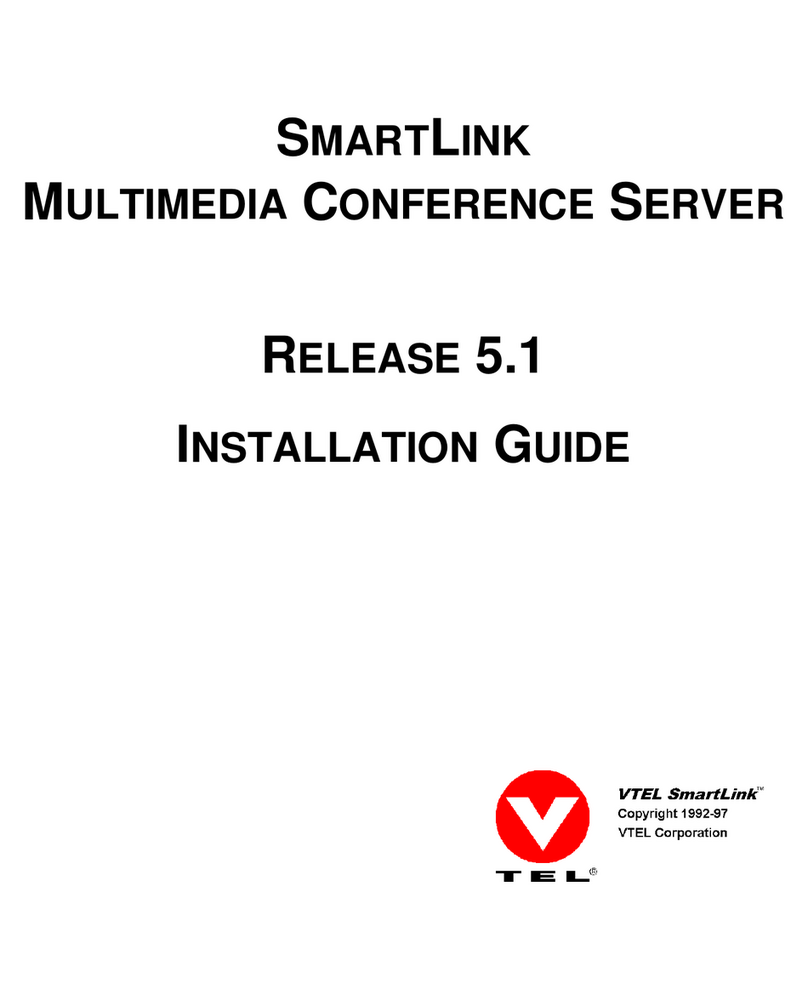
Smartlink
Smartlink Multimedia Conference Server installation guide

Samsung
Samsung MIM-D00 user manual
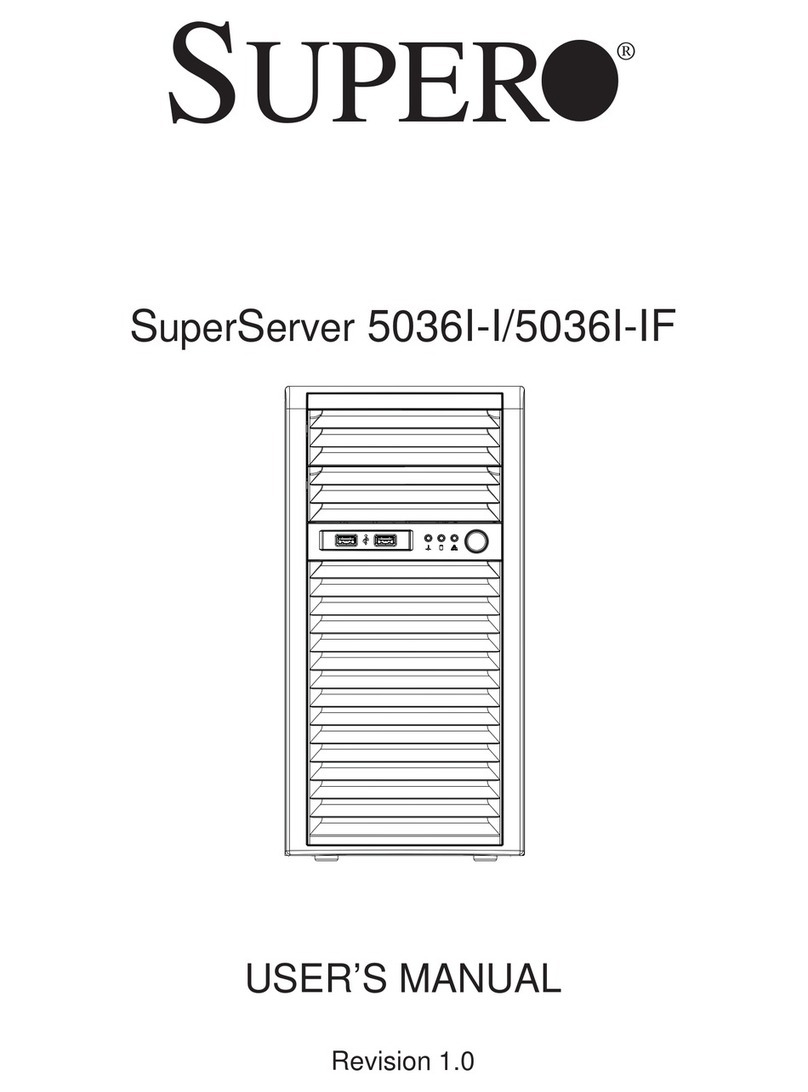
Supero
Supero SUPERO SuperServer 5036I-I user manual
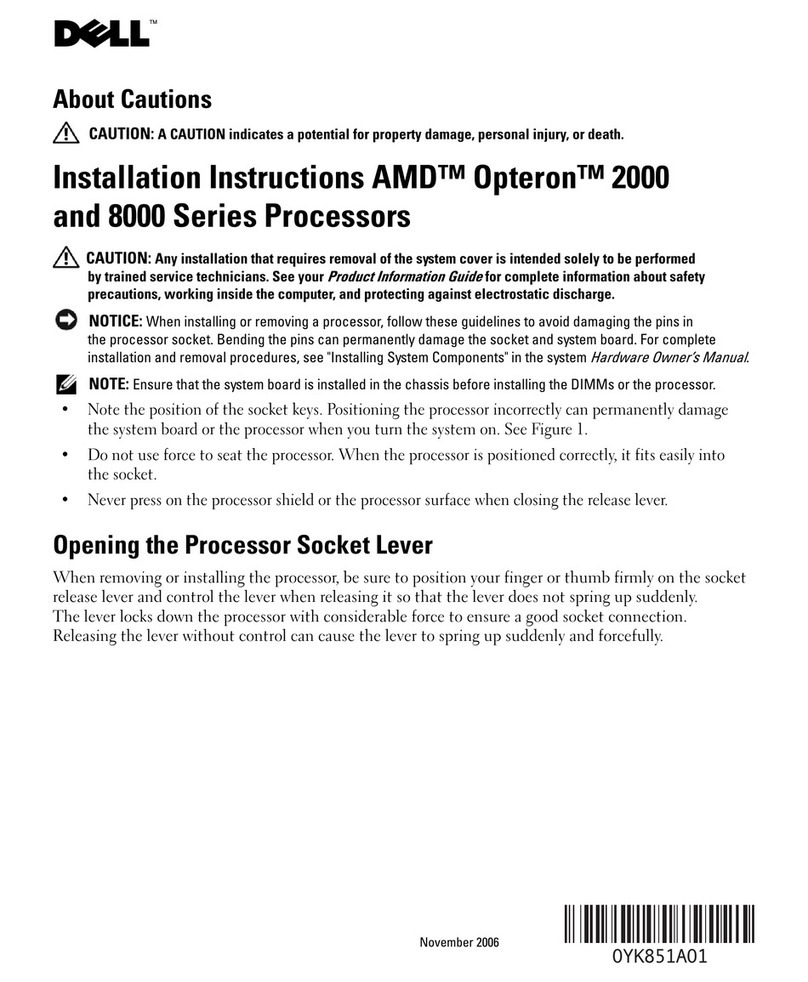
Dell
Dell PowerEdge 6950 installation instructions
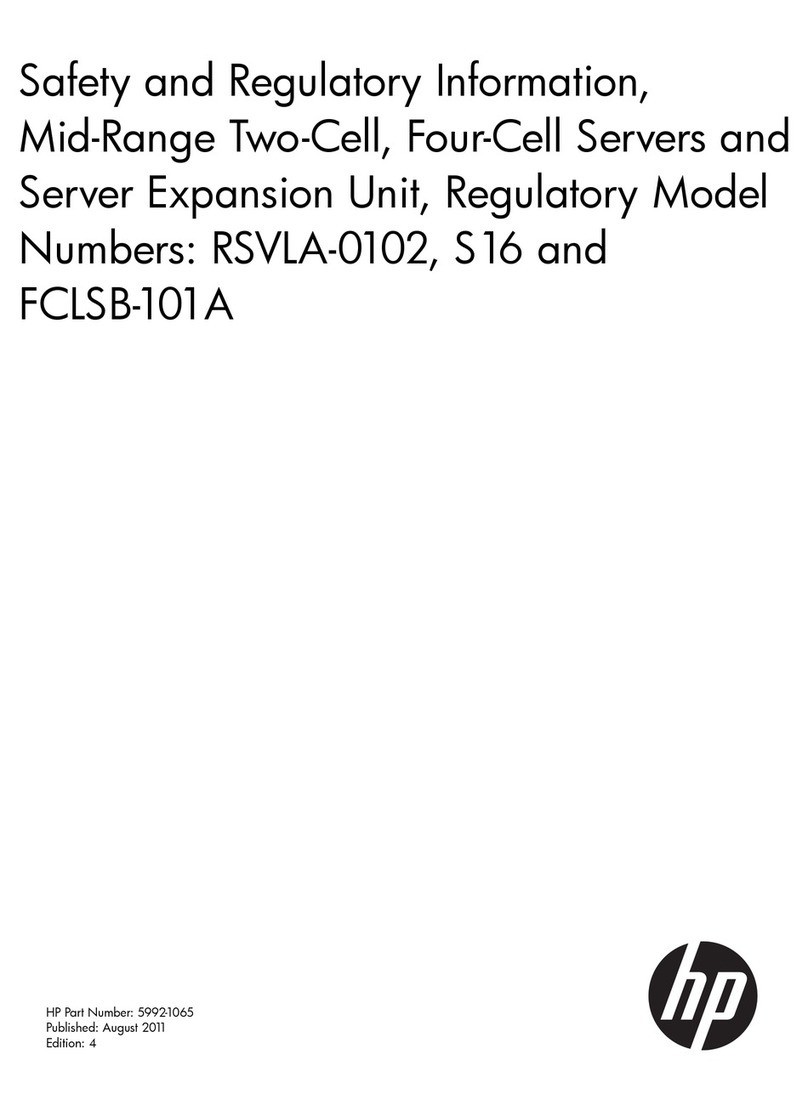
HP
HP 9000 rp7440 Safety and regulatory information


